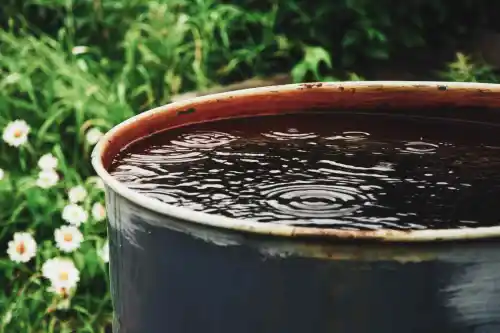 Add My Company
Add My Company
How to Collect Rainwater

Water is a finite resource in the UK and globally. Population growth continually increases demand, but climate change has greatly diminished rainfall in many areas.
Farmers and gardeners require large and constant quantities of water. With the right collection and storage facilities, you can collect rainwater to supplement your supply. It can even be better for plants and crops; minerals present in mains water can affect nutrient levels, but rainwater has a lower PH value which avoids this problem.
What Is a Good Way to Collect Rainwater?
Any structure with a roof can be used to collect rainwater. The water runs from the roof into the gutters and down through a pipe into a container on the ground below. A nozzle on the bottom of the container acts like a tap to allow the water to be emptied.
How to Collect Rainwater without Gutters
You may wonder how to collect rainwater without gutters, but there are several ingenious methods. Any type of roof must be designed to allow rainwater to flow off. Clearly, the water will come from all angles, but the roof design eventually channels the separate streams into one.
This is known as a catchment area, and it works in the same way as a gutter to contain the water and direct it down to the ground. A drainage pipe can be attached in the catchment area and directed down into a water container below.
Diverters are another effective way to collect rainwater. They work in the same way as gutters and look similar as well. These long sections of metal (a bit like a long tray) are placed over doors and windows to protect them from rain (in the absence of a gutter). A drainage pipe from the diverter collects the rainwater and diverts it into the storage container.
An umbrella water catcher (also known as a rain saucer) is another simple but effective method. In effect, this is an upside-down umbrella and it doesn’t even need to be mounted on a building. It sits on top of the container and channels the water directly into the storage area via a pipe connecting the two.
Is it Illegal to Collect Rainwater in the UK?
No, it’s perfectly legal to collect rainwater in the UK – indeed, most water authorities actively encourage households and businesses to do so if possible. This is particularly the case in areas with less rainfall, such as the southeastern counties,
although even in the wetter parts of the west and north it’s still a good way to save money and resources.
Although it isn’t illegal to collect rainwater in the UK there are regulations around how you store and use rainwater, as stipulated by the Environment Agency (EA). Untreated (non-potable) rainwater must not come into contact with drinking water for health and safety reasons. In addition, if you intend to mix harvested rainwater with other water – an inland watercourse or reservoir for example – you must have an abstraction license from the EA to do so.
Is it Safe to Drink Rainwater in the UK?
No, rainwater must be purified if you intend to drink it. You might think water falling from the sky is pure and safe to drink. Unfortunately, this isn’t the case. Very few parts of the planet are free from pollution and a lot of this lingers in the atmosphere.
Dust, bacteria, parasites and viruses can all be present, so rainwater is regarded as non-potable in the UK. However, it is possible to purify water so it’s safe to drink.
How Do You Purify Rainwater?
If you’re using rainwater for watering plants, irrigating crops or at home for the washing machine or bathroom you don’t need to purify it. However, it’s wise to do so.
In addition to pollutants in the atmosphere, harvested rainwater contains debris from the surroundings. Leaves, dirt, feathers and dust may all be lurking and if these go into the storage container you’ll end up with smelly and contaminated sludge in your supply.
A filter can be installed to the inlet of the rainwater container. This strains out foreign bodies before the water goes into the container. Remember to take account of the size of the water catchment area so that the filter is adequate for the volume of water. The filter should be checked and cleaned regularly to keep it in good working order.
Some particles may still remain, as they’re too fine for the filter – oil and pollen for example. These will rise to the surface but an overflow siphon installed in the tank catches these particles and separates them from the clean water.
IBC Containers – Safe, Strong And Versatile Storage Solutions
Intermediate bulk containers (IBCs) are the perfect way to store large quantities of liquids. They are commonly used for liquids such as:
- Chemicals
- Solvents
- Paint
- Ink
- Pharmaceuticals
- Drinking water
An IBC container is ideal for collecting and storing large volumes of rainwater for use in gardens and farms. They are available in a variety of sizes from 300 to 2,000 litres and can easily be filled from the top via a secure opening.
This opening also allows you to connect the IBC to a downpipe and rainwater harvesting system – a simple but efficient way to collect rainwater. The IBC has a nozzle at the base, which provides easy access and drainage.
Contact ITP Packaging to Find Out Which IBC Is Best to Collect Rainwater
IBC containers can be purchased new, rebottled or reconditioned depending on the liquid and its use. They come in a variety of designs depending on your requirements.
The sturdiest IBCs are protected within rigid steel cages that keep the contents safe during transit. They also have a steel pallet mount on the base, which allows them to be safely moved and stacked in a warehouse with ease.
Our experienced staff have all the expertise you need – whatever your requirements.
Contact our friendly team today to find out more
For more information on How to Collect Rainwater talk to ITP Packaging Ltd

